Freight Shipping between Thailand and Romania | Rates – Transit times – Duties and Taxes
Who knew shipping freight from Thailand to Romania could be as spicy as a bowl of Tom Yum soup? However, cracking the code to rates, transit times, and customs regulations can be quite complex. This guide will give you a comprehensive understanding of these factors, along with details on various freight options - be it by sea, air, road, or rail, and tips on customs clearance, duties, and taxes. Tailored to meet your specific business needs, this information is aimed to ensure smooth sailing for your shipment. Your business will also find tailored advice and practical steps to make this process easier. If the process still feels overwhelming, let DocShipper handle it for you! As an experienced international freight forwarder, we'll turn these challenges into stepping stones for your success.
Which are the different modes of transportation between Thailand and Romania?
Choosing the right transport method between Thailand and Romania is a bit like planning for a long cross-country journey. While air freight offers a speedy, albeit expensive route, likened to hopping on a plane, ocean freight is the scenic, economical road trip of the shipping world. Both routes have their challenges - think turbulence or traffic. But due to the physical distance and the intermingling international borders, shipping by road or rail might seem as impractical as a long hike. Your final decision? It's about matching your shipping needs to the transport equivalent of your perfect journey.
Need help with your shipment?
Need assistance with your shipment? Dont hesitate to contact us even for a simple question. Choose the option that suits you
Live chat with an expert Chat on WhatsApp Free Quote 24hHow can Siam Shipping help you

Sea freight between Thailand and Romania
Sailing your goods from the bustling ports of Thailand to the prosperous Romanian hubs can be akin to navigating a complex sea route – filled with potential obstacles but also marked by rewarding trade opportunities. The maritime bond these countries share is anchored in their booming trade relationship, with key cargo ports like Laem Chabang in Thailand and Constanta in Romania bridging vital industrial centers. However, the swell of the sea is not the quickest path, but it remains the most cost-effective for businesses handling high-volume goods, especially those playing the long game in international trade.
Why then do businesses stress over shipping between these nations, you wonder? It’s because the process can unexpectedly spring like a geyser, with hidden complexities lurking below the surface. But don’t let this scare you away from uncharted waters. There’s a charted course to steer clear of common shipping mistakes, and this part of our guide will serve as your compass, pointing towards best practices that can turn stormy shipment sagas into smooth sailing. In the end, the secret lies in grasping those intricate specifications that underlie this necessary voyage of trade. Clear seas ahead, let’s dive in!
Main shipping ports in Thailand
Port of Laem Chabang
Location and Volume: Located in Chonburi Province, Thailand, the Port of Laem Chabang is the third-largest gateway port in Southeast Asia and an important global shipping hub. It is situated in Bang Lamung District, Chon Buri. It provides easy access to important industries like automotive, electronics, petrochemicals, and food processing as a major participant in the Eastern Economic Corridor (EEC). As a key component of Thailand’s international trade, the port, which will handle 18 million TEUs of cargo in 2022, guarantees effective operations for shippers with competitive pricing and excellent connectivity via road, rail, air, and water
Key Trading Partners and Strategic Importance: The port is a critical trade hub for Southeast Asia, with key trading partners including China, the United States, Japan, and Singapore. Notably, it is the 22nd busiest container port in the world and plays a strategic role in Thailand’s Eastern Economic Corridor development plan.
Context for Businesses: For businesses seeking to expand their presence in Asia, the Port of Laem Chabang is particularly advantageous due to its capacity to handle large container ships and its convenient connections to major manufacturing zones.
Bangkok Port
Location and Volume: Located in Bangkok’s bustling Khlong Toei District, this port covers an area of roughly 1,473 acres and handles 8.7 million TEUs per year. It is well-known for its advantageous location and effective operations, acting as a vital hub for global business connectivity and international trade.
Key Trading Partners and Strategic Importance: Important trade partners include China, Japan, the United States, and other ASEAN countries. It holds importance as a domestic gateway and handles a significant amount of the country’s rice exports.
Context for Businesses: If your business deals primarily with domestic distribution within Thailand or focuses on agricultural exports, the Port of Bangkok’s strategic inland location and extensive river network connectivity can be beneficial.
Port of Map Ta Phut
Location and Volume: Situated in Rayong Province, Thailand, the Port of Map Ta Phut is a pivotal maritime facility handling bulk and liquid cargo. It ranked as the world’s 8th largest port by cargo volume in 2017.
As the second-largest port in Southeast Asia, it plays a crucial role in petrochemicals, refining, and manufacturing. Embraced by the Eastern Economic Corridor (EEC), the port offers seamless connectivity via road, rail, air, and water transportation. With an anticipated handling capacity of around 16 million TEUs per year, it cements its position as a key player in Thailand’s international trade network.
Key Trading Partners and Strategic Importance: The port is crucial for chemical and petrochemical industries, with primary trading partners including Japan, China, and South Korea, and it is integral to Thailand’s petrochemical industry.
Context for Businesses: If your enterprise operates within the petrochemical or bulk commodity sectors, Map Ta Phut’s specialized facilities and strong industrial connections will likely be instrumental to your logistics plan.
Port of Songkhla
Location and Volume: Nestled on the eastern side of the southern Thai peninsula, the Port of Songkhla stands as a vital maritime gateway, specializing in the handling of diverse agricultural goods. With a robust shipping capacity of approximately 3 million tons annually, this strategic port plays a pivotal role in facilitating the export and import of agricultural products, contributing significantly to the regional and national trade landscape. Its geographical location on the southern coast enhances accessibility, fostering efficient maritime operations for the seamless movement of goods.
Key Trading Partners and Strategic Importance: It serves as a vital link for Thailand’s southern provinces and its key trading partners are Malaysia, Singapore, Indonesia, and India. The port also holds regional strategic significance, particularly for rubber and seafood exports.
Context for Businesses: For businesses operating in the rubber and seafood sectors, or those looking to access markets in Thailand’s southern region and neighboring countries, the Port of Songkhla could be an essential part of your shipping strategy.
Port of Sattahip
Location and Volume: Positioned further south on the Gulf of Thailand in Chonburi, the Port of Sattahip is a multifaceted maritime facility serving both military and commercial purposes. This strategic port, with its unique dual role, plays a crucial role in facilitating the movement of not only military assets but also commercial cargo. With an annual shipping volume exceeding 1.1 million TEUs, the Port of Sattahip contributes significantly to the region’s trade activities. Its dual functionality underscores its versatility, making it a key asset for both military logistics and the broader commercial shipping industry in the Gulf of Thailand.
Key Trading Partners and Strategic Importance: This port contributes to the trade between Thailand and nations such as China, the US, Japan, and Singapore. It also holds strategic importance for military and defense purposes.
Context for Businesses: If you’re working in the defense industry or require tight security protocols, the Port of Sattahip, with its reliable infrastructure and military oversight, could potentially aid your logistics strategy.
Port of Ranong
Location and Volume: Situated amidst the picturesque scenery of Ranong Province, a major port complex occupies 27.2 acres, demonstrating its importance as a major seaport. This facility effectively handles 1.3 million tons of cargo annually, demonstrating its critical role in promoting trade and commerce. The port acts as a vital link for companies and sectors in the area and as a gatekeeper, promoting efficient and reliable transportation systems. Because of its advantageous location and strong infrastructure, the area is economically vibrant and plays a significant role in the trade landscape of Ranong Province.
Key Trading Partners and Strategic Importance: The Port of Ranong is an important maritime boundary between Thailand and Myanmar, making it a key trade gateway for the two nations.
Context for Businesses: Companies looking to facilitate trade with Myanmar or deal with bulk commodities such as coal, cement, or agriculture may find the Port of Ranong to be an essential addition to their logistics strategy.
Main shipping ports in Romania
Port of Constanta
Location and Volume: Situated on the western coast of the Black Sea, the Port of Constanta stands as a cornerstone of European trade, boasting a remarkable shipping volume of approximately 75.5 million tons in 2022. This bustling maritime hub plays a crucial role in connecting Europe to the world, serving as a gateway for a diverse array of goods and fostering economic growth across the continent.
Key Trading Partners and Strategic Importance: Although trade is diverse, key partners include Germany, Hungary, Austria, and Switzerland. This port is Romania’s maritime gateway and has the largest terminal of its kind in the Black Sea and Eastern Mediterranean zones.
Context for Businesses: If you’re seeking a port with extensive inland connections, the Port of Constanta could be a valuable asset in your shipping strategy. Its impressive network of road, rail, and river links connects Central and Eastern Europe, making sustainable distribution possible.
Mangalia Port
Location and Volume: Nestled along the Black Sea coast south of Constanta, Mangalia Port holds the distinction of being Romania’s southernmost maritime port. While its primary focus lies in facilitating passenger and tourism traffic, it also plays a supportive role in the local economy, handling a modest volume of goods. In 2022, the port handled an estimated 20,000 TEUs, reflecting its growing importance in the region’s maritime landscape.
Key Trading Partners and Strategic Importance: Most shipments from Mangalia are domestic or within the Black Sea region. It hosts important ship repair yards and yacht marinas supporting the domestic market.
Context for Businesses: If you operate in the tourism sector or require ship repair services, Mangalia Port should be on your radar. While not a heavy-hitter for cargo, its specialized services and location might align closely with your logistics needs.
Port of Galati
Location and Volume: Strategically positioned in eastern Romania along the meandering Danube River, the Port of Galati holds the distinction of being the largest river port in the country. With a bustling cargo throughput of approximately 19 million tons in 2019, the port plays a pivotal role in facilitating the movement of goods, predominantly bulk materials, across the region. In 2022, the port is projected to handle an estimated 50,000 TEUs, reflecting its expanding role in containerized cargo transportation.
Key Trading Partners and Strategic Importance: Key trading partners are primarily EU countries. A significant proportion of imports and exports are metal and steel goods, agricultural produce, and minerals.
Context for Businesses: If your trading focus lies within the European Union or your goods are heavy, bulky consignments, consider the Port of Galati. With its strategic position and capabilities in handling heavy goods, it could be a fitting choice for your logistics strategy.
Port of Tulcea
Location and Volume: Situated in the northeastern corner of Romania, the Port of Tulcea stands as a vital link along the strategically important Danube River. While its cargo volume may not rival that of Galati, it continues to play a crucial role in facilitating the movement of goods to and from Central Europe, handling an estimated around 70,000 TEUs in 2022. Its strategic location and growing infrastructure make it a promising hub for future trade expansion.
Key Trading Partners and Strategic Importance: Tulcea mainly services the European market and is a big player in routing goods through the wider Danube River network.
Context for Businesses: If you’re considering river shipping as a cost-effective means of transporting goods into Central Europe, the Port of Tulcea could be a valuable stop.
Port of Braila
Location and Volume: Strategically positioned on the Danube River approximately 20 nautical miles from Galati, the Port of Braila plays a crucial role in supporting local commerce, despite its total shipping volume being lower compared to other ports. In 2022, the port handled an estimated 3 million tonnes, reflecting its significance in facilitating the movement of goods and contributing to the region’s economic growth.
Key Trading Partners and Strategic Importance: Braila’s principal trading partners are within the EU, similar to Galati and Tulcea.
Context for Businesses: The Port of Braila could be a good consideration for smaller scale businesses aiming for seamless logistics solutions within the European Union.
Port of Sulina
Location and Volume: Situated at the confluence of the Sulina Arm of the Danube River and the Black Sea, the Port of Sulina serves primarily as a gateway for tourism and passenger traffic. While its cargo handling activities are relatively limited, it remains an essential component of the region’s maritime infrastructure, handling an estimated 15,000 TEUs in 2021.
Key Trading Partners and Strategic Importance: Trading is largely domestic or within the Black Sea region. The port provides unique opportunities for ship repair and marine leisure activity businesses.
Context for Businesses: Although the Port of Sulina has less significance in large-scale cargo handling, it could prove beneficial for businesses in the tourism or marine leisure sectors.
Should I choose FCL or LCL when shipping between Thailand and Romania?
Opting for Consolidation or Full Container shipping between Thailand and Romania? It’s a strategic choice with far-reaching impact on cost, timing, and successful delivery. Both methods, Full Container Load (FCL) and Less than Container Load (LCL), have unique advantages. Understanding these options can empower your business, help you keep costs down, timings accurate, and shipments secure. Get ready to dive into the ins and outs of sea freight, and tailor your choice to your specific needs for a smooth international shipping experience.
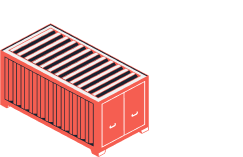
Full container load (FCL)
Definition: FCL (Full Container Load) shipping, as the name suggests, involves booking an entire container (20'ft or 40'ft) for your cargo. This is a cost-effective option when shipping large volumes. When to Use: FCL is generally more economical and secure for high volume shipments. If your cargo is more than 13/14/15 CBM, it's likely more cost-efficient to choose FCL. Your goods remain in a sealed container from origin to destination, reducing the risk of damage or loss in transit. Example: Let's say your business in Thailand is shipping 600 LED TVs to Romania. With their collective volume exceeding both a 20'ft and 40'ft FCL container capacity, an FCL shipping option would be the best choice in terms of cost and ensuring safe delivery. Cost Implications: When requesting an FCL shipping quote, you'll often discover it's more affordable than LCL when transporting large volumes. As you pay for the whole container, the cost per unit typically decreases with more goods. But remember, you'll bear the total cost whether the container is fully loaded or not. Maximizing space utilization is key for cost-efficiency.
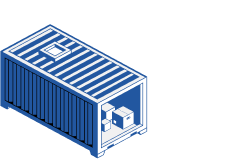
Less container load (LCL)
Definition: Less than Container Load (LCL) shipping, also known as groupage, is a method of transporting goods that don't take up an entire container. It's a shared service where you only pay for the volume your cargo occupies within the container, and your goods come along with others. When to Use: LCL shipping is more economical and flexible for businesses shipping small volumes of goods, typically less than 13/14/15 Cubic Meters (CBM). It's perfect for low supply and inconsistent demand typical in growing businesses, or for testing new markets. Example: Imagine you operate a Romanian startup selling unique artisanal crafts imported from Thai villages. Your initial orders might be small - a few hundred pieces that may fill up to 10 CBM in a container. Instead of booking an entire 20-foot container (around 30 CBM), you’d opt for an LCL shipment, saving on shipping costs. Cost Implications: Cost efficiency is the primary reason why businesses opt for LCL freight. By sharing container space, you only pay for the volume you occupy. However, remember that extra handling might incur additional costs: your cargo is combined and de-consolidated with others, which might slightly increase the cost per unit compared to Full Container Load (FCL).
Hassle-free shipping
With a mission to streamline your cargo shipping experience, DocShipper presents a team of ocean freight specialists ready to support you. Whether it's cost-efficiency, space requirements, or transit times - our team considers every angle, walking you through the process of choosing between consolidation and full container shipping. Your decision between Thailand and Romania remade easy. Don't be swayed by the waves; reach out now for a free estimation tailored to your specific needs. Let's set sail together for successful business voyages.
How long does sea freight take between Thailand and Romania?
Shipping goods from Thailand to Romania by sea freight takes an average of 24 to 30 days. This transit time considers various factors such as the specific ports used, the weight of consignment, and the nature of the shipment’s goods. Remember, these averages are estimated and actual transit times might slightly differ. For a more accurate and bespoke quote for your shipping needs, we recommend reaching out to an expert freight forwarder like DocShipper.
Here’s a quick insight through a text-only table on average transit times between main freight ports in both countries:
Port in Thailand Port in Romania Average Transit Time Laem Chabang Constanta 25-30 days Bangkok Constanta 22-27 days Map Ta Phut Constanta 23-28 days Songkhla Constanta 26-31 days*Please be aware that these are only estimates that could change depending on the previously listed variables. It is advisable to get in touch with a seasoned freight forwarding company for more specific information.
How much does it cost to ship a container between Thailand and Romania?
Assessing the exact shipping cost between Thailand and Romania can be a complex task. Ocean freight rates per Cubic Meter (CBM) can vary widely and depend on numerous factors such as the Point of Loading and Destination, the carrier chosen, the type of goods shipped, and even monthly market fluctuations. Despite these intricacies, there’s no need for you to be burdened with uncertainty. Our seasoned shipping specialists are committed to working closely with you, employing their expertise to navigate this fluctuating landscape and secure the most competitive rates. Each quote is specifically tailored to your unique needs, ensuring best return on your shipping investment. Rest assured, your freight needs are our priority.
Special transportation services
Out of Gauge (OOG) Container
Definition: An OOG container, also known as Out of Gauge cargo, is specifically designed to handle goods that exceed ordinary shipping dimensions in terms of height, width, or length. Suitable for: Unusual, oversize freight items such as heavy equipment, machinery, or large parts are often shipped using this method. Examples: Industrial machinery components, windmill propellers, and construction material such as girders and beams. Why it might be the best choice for you: If your business is involved in shipping oversize items that won’t fit into a regular 20 or 40-foot container, OOG is the ideal solution ensuring safe handling of your goods regardless of their size.
Break Bulk
Definition: This is a method of shipping loose cargo that is not containerized but packaged or bundled, also known as break bulk. Suitable for: Bulkier items that don’t fit into traditional shipping containers and are not suitable for OOG containers due to their abnormal contours. Examples: Large pipes, timber, pre-packaged manufactured goods. Why it might be the best choice for you: If your business ships non-containerized and odd-shaped cargo infrequently, break bulk shipping is cost-effective and provides more flexibility in cargo handling.
Dry Bulk
Definition: This shipping method refers to the transportation of loose cargo like aggregates, which is loaded and discharged with a shovel or bucket – often referred to as dry bulk. Suitable for: Commodities shipped in large quantities like coal, iron ore, grain, and sand. Examples: Bulk grains, coal, or construction materials like stones and sand. Why it might be the best choice for you: If your business involves shipping commodities in high quantities, dry bulk cargo shipping has significant cost benefits due to its high capacity.
Roll-on/Roll-off (Ro-Ro)
Definition: Ro-Ro vessels are ships designed for transporting wheeled cargo that can be driven on and off the ship – typically using a built-in ramp. Suitable for: Vehicles like cars, trucks, trailers, and railroad cars, or any heavy machinery that can be moved around on wheels. Examples: Automobiles, buses, tractors, or even mobile cranes. Why it might be the best choice for you: Should your business involve transportation of motorized vehicles or rolling machinery, the Ro-Ro method can provide you with a hassle-free and efficient shipping solution.
Reefer Containers
Definition: Reefer containers are refrigerated shipping containers for goods that need temperature-controlled transportation. Suitable for: Perishable goods including fruits, vegetables, dairy products, or medical supplies that require cold or freezing temperatures. Examples: Fresh fruit, dairy products, pharmaceuticals, or seafood. Why it might be the best choice for you: If your business requires the transportation of perishable or temperature-sensitive goods, using reefer containers ensures that your cargo reaches its destination without spoilage.
As an expert in international logistics, DocShipper understands that every businesses’ needs are unique. Whether you’re shipping dry bulk or require a reefer container for perishable goods, we can provide you with an optimized solution. Contact us today for a free shipping quote tailored to your specific needs within 24 hours.

Air freight between Thailand and Romania
Air freight between Thailand and Romania offers a rapid and reliable shipping route for your trade needs. Ideal for small, high-value items like electronics or important documents, it strikes a perfect balance between speed and cost. Imagine your shipment on a bullet train, zipping past towering mountains–that’s the efficiency air freight offers! But here’s the catch: many shippers stumble with the fine print. Misjudging the weight formula while estimating cost, unaware of industry tactics, and overlooking best practices can turn the speed of air freight into a costly whirlwind. In this guide, we’ll debunk these pitfalls, making your air freight journey as smooth as a clear sky.
Air Cargo vs Express Air Freight: How should I ship?
Wondering how to zip your goods from Thailand to Romania without a glitch in your supply chain? Selecting between air cargo and express air freight can be tricky. Picture air cargo like booking a seat on an airline, while express air freight is more like reserving an entire dedicated plane – speedy, yes, but at a premium cost. So, how should your business ship? Let’s take a deep dive into these options and find your perfect balance of cost efficiency and timeliness.
Should I choose Air Cargo between Thailand and Romania?
Forging a path by air cargo between Thailand and Romania can be fitting if your needs align with cost-effectiveness and reliability. Esteemed airlines like Thai Airways and TAROM Romanian Air Transport provide these services, becoming more competitive if your cargo exceeds 100/150 kg (220/330 lbs). While the transit times might be a tad longer due to predetermined schedules, it’s a choice worth considering in balancing your shipping expenses and ensuring consistent delivery.

Should I choose Express Air Freight between Thailand and Romania?
Opting for express air freight, a service utilizing exclusive cargo planes with zero passengers, could be a savvy decision for smaller shipments from Thailand to Romania. Ideal for cargo under 1 CBM or weighing 100/150 kg (220/330 lbs), it offers speedy and efficient delivery. Trustworthy international couriers like FedEx, UPS, or DHL specialize in this service, ensuring safe and prompt deliveries. Whether you’re sending essential business documents or small goods, express air freight might just be your best bet.

Main international airports in Thailand
Suvarnabhumi Airport
Cargo Volume: In 2022, Suvarnabhumi Airport handled 97,700 million tons of cargo. Key Trading Partners: China, Japan, the United States, and the European Union are key trading partners. Strategic Importance: This is Thailand’s primary airport, strategically located in the capital city of Bangkok. It serves as a major cargo hub in Southeast Asia thanks to the extensive network of direct flights. Notable Features: The airport has a dedicated perishable goods facility and features the most modern cargo technology. For Your Business: Given its excellent connectivity and modern facilities, Suvarnabhumi Airport could be a strong investment if you’re exporting perishable goods or high-tech products.
Don Mueang International Airport
Cargo Volume: In 2022, Don Mueang International handled around 35,000 tons of cargo. Key Trading Partners: The key trading partners through this airport are China, India, and ASEAN countries. Strategic Importance: This is Thailand’s second busiest airport. Located in Bangkok, it serves mostly low-cost carriers and offers an economical option for cargo transportation. Notable Features: Less crowded than Suvarnabhumi, it offers quicker processing times for cargo. For Your Business: Don Mueang can be a beneficial choice for businesses seeking cost-effective and efficient shipping solutions, particularly for transacting with China, India, or ASEAN nations.
Phuket International Airport
Cargo Volume: The total cargo volume for Phuket International was approximately 25,000 tons in 2023. Key Trading Partners: Major trading partners include China, Australia, and European countries. Strategic Importance: The airport is a significant gateway to southern Thailand and serves as a good option for air freight to popular tourist destinations. Notable Features: The airport is especially known for its strong reputation in the efficient handling of courier parcels. For Your Business: If your business is catering to the tourism or retail sectors in southern Thailand, Phuket International could be an appropriate choice.
Chiang Mai International Airport
Cargo Volume: Chiang Mai International handled approximately 18,000 tons of cargo in 2022. Key Trading Partners: Key trading partners are China, Singapore, and Malaysia. Strategic Importance: As the country’s northern hub, this airport facilitates trade with China and the northern ASEAN region. Notable Features: The airport has a dedicated terminal for cargo, with a focus on agricultural products export. For Your Business: If your business is involved in the agriculture sector, Chiang Mai’s capacity and location could provide unique commercial opportunities.
U-Tapao International Airport
Cargo Volume: U-Tapao Airport cargo volume is steadily growing with precise figures not readily available due to its shared usage with the Royal Thai Navy. Key Trading Partners: The main trading partners are China, Russia, and the ASEAN countries. Strategic Importance: This airport serves the eastern seaboard of Thailand, the country’s main industrial region, thereby playing a crucial role in the nation’s industrial development. Notable Features: It’s primarily a military airport but is quickly growing as an alternate to Bangkok airports for both passenger and cargo flights. For Your Business: If your business is closely tied to the industrial sector, particularly in Eastern Thailand, U-Tapao is a compelling choice as it has excellent road links to nearby industrial estates.
Main international airports in Romania
Henri Coandă International Airport
Cargo Volume: Over 150,000 tonnes of cargo annually, making it the busiest in Romania. Key Trading Partners: Primarily engages with European Union countries, especially Germany, Italy, and France. Strategic Importance: Located in Bucharest, the capital city, it serves as the main hub for air freight transportation in Romania, connecting to over 65 destinations worldwide. Notable Features: Utilizes state-of-the-art technology for cargo handling and storage, complete with areas designated for storing hazardous and refrigerated goods. For Your Business: Its robust infrastructure, robust handling capabilities, and strategic location make it ideal for the transportation of a wide range of commodities. If your company frequently ships to or from Europe, this airport should be top of your consideration.
Cluj-Napoca International Airport
Cargo Volume: Handles around 15,000 tonnes of cargo annually. Key Trading Partners: Mainly services countries within the European Union with Germany and France as leading partners. Strategic Importance: As the second largest airport in Romania, it is a key freight hub, particularly for Northern Transylvania, and offers connections to more than 40 destinations. Notable Features: Offers a wide range of cargo handling capabilities, including special storage facilities for perishable, valuable, and hazard categories. For Your Business: If your business caters to the Northern Transylvania region or wishes to target European markets, this airport provides a trustworthy and strategic option.
Timisoara International Airport
Cargo Volume: Manages around 13,000 tonnes of cargo each year. Key Trading Partners: Conducts business mainly with countries in the European Union. Strategic Importance: Serves as a critical logistics and freight hub for Western Romania, offering regular flights to over 20 destinations. Notable Features: The airport has recently undergone impressive expansion and modernization efforts, improving its cargo handling, storage, and processing capacities. For Your Business: If Western Romania or the connected European markets align with your business growth strategy, take advantage of Timisoara’s modernized facilities and services.
Sibiu International Airport
Cargo Volume: Handles approximately 3,600 tonnes of cargo per annum. Key Trading Partners: Engages predominantly with European Union countries. Strategic Importance: The airport effectively serves Central Romania and offers direct connections to more than 10 international destinations. Notable Features: Potential for expansion and modernization to accommodate the growing demand for cargo transportation. For Your Business: This could be an excellent opportunity for businesses looking to expand their reach to Central Romania or related European markets with potential for increasing cargo demands.
Bacau International Airport
Cargo Volume: Handles about 2,500 tonnes of cargo yearly. Key Trading Partners: Primarily does business with countries within the European Union. Strategic Importance: Important freight hub for Eastern Romania, with direct connections to several European destinations. Notable Features: Compact airport with efficient cargo handling capabilities. For Your Business: If Eastern Romania or the associated European corridors are pivotal to your freight operations, Bacau International Airport offers efficient cargo services that can facilitate your business needs.
How long does air freight take between Thailand and Romania?
Shipping from Thailand to Romania by air freight typically takes between 5 to 7 days, although this can vary. Your shipment’s transit time depends on a variety of factors including the specific departure and arrival airports, the weight of your goods, and their nature. So, whether you’re transporting delicate ceramics or heavy machinery will affect your timelines. For accurate, detailed estimates, it’s advisable to consult a freight forwarder such as DocShipper.
How much does it cost to ship a parcel between Thailand and Romania with air freight?
The cost to ship an air freight parcel between Thailand and Romania typically ranges from $3-6 per kg; however, several factors challenge this estimate. Due to collective influences such as distance from airport, parcel dimensions, weight, and product nature, it is impossible to present a one-size-fits-all pricing approach. With every shipment, our team considers these unique aspects, providing personalized quotes for each customer to ensure the best possible rates. We invite you to contact us. Within 24 hours, we’ll deliver a free quote, tailored to fit your specific shipping needs.
What is the difference between volumetric and gross weight?
Understanding the difference between gross weight and volumetric weight in air freight shipping is crucial to adequately plan your shipments from Thailand to Romania.
Gross Weight is simply the total actual weight of a shipment, including goods and packaging. It’s measured in kilograms (kg) and can be easily determined using a scale.
Conversely, Volumetric Weight takes into account the space your shipment occupies in the aircraft. It gives an equivalent weight based on the volume, not just the physical weight. This is because air freight carriers must account for both the size and weight of a shipment.
To calculate the gross weight in Air Cargo services, you weigh your whole package and get the total in kilograms. In Express Air Freight services, the process remains the same.
For Volumetric weight, the calculation process differs. In Air Cargo, you multiply the length, width, and height of your package (in cm), then divide by 6000. In Express Air Freight, you use the same multiplication but divide by 5000 instead.
Let’s take an example of a shipment with the size 40cm x 30cm x 20cm and let’s say it physically weighs 7 kg. In Air Cargo, the volumetric weight is (40 x 30 x 20) / 6000, equating to 4 kg (or 8.8 lbs). In Express Air Freight, it comes to 4.8 kg (or 10.6 lbs). The gross weight is 7 kg (or 15.4 lbs).
Now why do these calculations matter? Because your freight charges will be measured against both. The carriers will charge you based on whichever weight – the gross weight or the volumetric weight – is higher. Understanding this will help you budget better for your shipments.

Door to door between Thailand and Romania
Unlock tension-free international trade with Door to Door shipping between Thailand and Romania! Here, we’re managing every step, all from your doorstep in bustling Bangkok to a warehouse in historic Bucharest. This seamless, cost-effective solution alleviates much of the logistical headache. Can’t wait to reap these benefits? Let’s dive right in!
Overview – Door to Door
Taking the hassle out of the international shipping process, Door to Door shipping between Thailand and Romania is your ticket to stress-free logistics. As a popular service among our DocShipper clients, it consolidates the complexities of transportation, customs clearance, and paperwork. The service, while cost-effective, does require a bit more time, an important consideration for time-sensitive goods. However, it’s ideal for handling the intricate task of shipping, ensuring your goods arrive safe and sound without you breaking a sweat.
Why should I use a Door to Door service between Thailand and Romania?
Ever broke a sweat puzzling over logistics? Let’s see why the Door to Door service between Thailand and Romania could be the top-secret solution you’ve been looking for.
Negate Nerve-wracking Logistics: Coordinating various stages of delivery can cause a lot of stress. But guess what? This service takes logistics off your plate, handling everything from pick-up in Thailand to drop-off in Romania! Too Urgent for Uncertainties: Tick-tock, time-sensitive cargo incoming! The Door to Door service is like a logistician’s ninja, smoothly ensuring faster delivery by eliminating the need for transitions between transport services. Delicate shipments: If your cargo is delicate, hazardous, or otherwise demanding, fear not. This service offers specialized care, making sure even the most complex shipments can safely make their Euro-Asian journey. Convenience Named Door to Door: This service is like that friend who always does you a solid. It literally does the heavy lifting, taking responsibility for every aspect of the freight trucking from Thailand to Romania. Tired of coordinating with multiple parties? Door to Door’s got your back! Always in the Loop: Transparency for the win, right? Door to Door provides tracking, meaning you’re never in the dark about your shipment’s whereabouts.In short, the Door to Door service between Thailand and Romania transforms your shipping experience, providing the peace of mind you need to focus on what you do best – growing your business.
DocShipper – Door to Door specialist between Thailand and Romania
Choose DocShipper for stress-free, door-to-door shipping between Thailand and Romania. Expect expertise and proficiency as we handle every step – from packing to transportation, custom clearances, and selecting the right shipping method. For worry-free shipping, trust us. We even assign a dedicated Account Executive to ensure smooth logistics. Get access to free estimates in under 24 hours or call our consultants anytime, all at no cost. Let DocShipper be your partner in seamless, end-to-end international freight forwarding.

Customs clearance in Romania for goods imported from Thailand
Navigating the maze of customs clearance can be complex and confusing, especially when shipping goods from Thailand to Romania. It’s not as simple as packaging your goods and waiting for them to arrive. There is always a risk of unforeseen fees or goods getting stuck in the bureaucratic labyrinth. To avoid this, it’s crucial to understand customs duties, taxes, licenses, and quota systems like the back of your hand.
Don’t worry, though, we’ll deep dive into these aspects to prepare you for the challenge. And of course, our team at DocShipper is here to assist you with any kind of merchandise, anytime, anywhere. Need an estimate to price your project? Reach out to us with the origin of your goods, their value, and the HS Code. These three components are indispensable for us to help you effectively with your estimate.
How to calculate duties & taxes when importing from Thailand to Romania?
Getting your products from Thailand to Romania smoothly goes beyond just managing transportation. A vital part of your shipping process is estimating and handling duties and taxes that your shipment might incur. This isn’t just a mere guesswork – it requires an understanding of the origin of your goods, their Harmonized System (HS) Code, the customs valuation, the specific tariff rate, and the potential application of other charges such as Value Added Tax (VAT), excise duty or other fees.
The journey to estimating your import duties begins at home – or more specifically, at the place where your products took form. Identifying the country where your goods have been manufactured or produced is your crucial first step. From knowing whether it’s a technologically-advanced plant in Bangkok or a handicraft workshop in Chiang Mai, this piece of information will lay down the foundation for your duty and tax calculations.
Step 1 – Identify the Country of Origin
Identifying the Country of Origin is more than a box-ticking exercise. It has five crucial roles:
1. It helps determine applicable duties and taxes under Romania’s import laws.
2. Know that Thailand and Romania share special trade agreements which can potentially lower duty rates. Essential savings, right?
3. Get the exact Harmonized System Code (HS code) for your product to avoid complications down the line.
4. Uncover any hidden import restrictions or bans specific to imports from Thailand. Don’t want your goods held at customs, do you?
5. Lastly, fluff up your paperwork. Yes, having the correct Country of Origin gives that added polish to customs documentation, leading to swifter clearance times.
Quick tip: Stay informed about the ASEAN-EU Free Trade Agreement struck between the two countries. It could mean significant duty reductions for your business, so keep tabs. Remember, each trade agreement has its own criteria, so always cross-check if your goods fall under its scope. Next time you don’t overlook the ‘Country of Origin’ label, it’s your key to unlock hassle-free shipping.
Step 2 – Find the HS Code of your product
The Harmonized System (HS) Code is a universally standardized system of names and numbers to classify traded products. It’s widely adopted by countries worldwide to underscore customs duties, tax rates, and for international trade statistics. Knowing the HS code of your goods is crucial and it is typically the supplier who can provide this, given their extensive knowledge about what they are exporting and the associated regulations.
However, if the HS code from the supplier is unavailable, there is no need to worry. You can easily find it by following these simple steps:
Navigate to the Harmonized Tariff Schedule available at this link. Enter your product name into the search bar and initiate the search. In the returned results, refer to the Heading/Subheading column where you’ll find the desired HS code.Please remember the importance of accuracy when choosing the HS code. Misrepresentation or incorrect coding can lead to unnecessary delays and potential fines during the clearance process, so take your time and ensure you’ve got it right.
Here’s an infographic showing you how to read an HS code. This will help demystify the structure of the HS code and further assist you in the classification of your goods.

Step 3 – Calculate the Customs Value
Deciphering the customs value of your goods from Thailand, arriving in Romania, might seem like a complex knot to untie. It’s important to know this isn’t just the product cost. The customs value, also known as the CIF (Cost, Insurance, and Freight) value, is the sum of three components – the price of your goods, the cost of international shipping, and the insurance cost.
Let’s say you purchased goods for $10,000. Shipping cost is $1,000 and the insurance cost is $200. Therefore, your CIF value is $11,200 ($10,000+$1,000+$200). This CIF value is used as a base to calculate your potential customs duty and taxes. Understanding this breakdown makes the process less intimidating and gives a clearer picture of your total import costs! By incorporating this, you’ll tackle potential financial pitstops head-on, resulting in smoother freight forwarding to Romania.
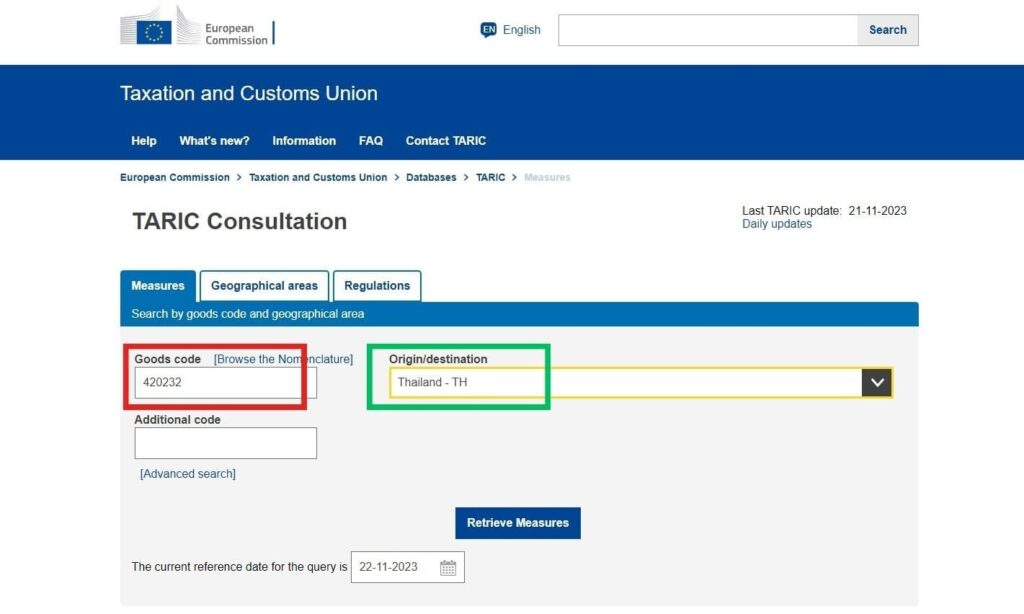
Step 5 – Consider other Import Duties and Taxes
When importing goods from Thailand to Romania, aside from the standard tariff rate, you might come across additional import duties. These vary depending on the origin country and the imported product’s nature. Let’s break these down.
Excise Duty is a tax applied to certain goods like tobacco and alcohol. Say you are importing whiskey worth $5000, subject to an excise rate of 5%. Your excise duty will therefore be $250. However, note that these rates and provisions can change, so stay updated.
Anti-Dumping Tax targets imported goods sold below market price, protecting domestic industries from unfair competition. As an example, if you import goods valued at $5000 and find yourself faced with an anti-dumping tax rate of 20%, your anti-dumping tax will be $1000.
Finally, we have the Value Added Tax (VAT). In Romania, the standard VAT rate is 19%. Applied to the aggregate of the customs value plus any duty/taxes charged, it is a significant component of your total landed cost. For example, if your total duty and taxes payable come to $1500 (excluding VAT), the VAT payable would be $285 (19% of $1500).
Understand that these are just examples and actual rates can vary significantly. Always confirm current rates and regulations.
Step 6 – Calculate the Customs Duties
Cracking the code to calculating customs duties isn’t as difficult as you might think. We will help you discover the blueprint using customs value, VAT, and other taxes.
Imagine a shipment from Thailand to Romania with a customs value of $1000. Without VAT or other taxes, you’ll pay around $50 in customs duty (assuming a 5% rate).
Next, consider a case with the same customs value but with a VAT rate of 20%. Here, your total cost would be about $610 ($50 customs duty + $200 VAT), calculated on the total value plus the duty.
Lastly, imagine a scenario with customs value, VAT, tax, anti-dumping tax of $60, and an additional excise duty of $50. The resulting total for clearance would be $970 ($50 customs + $200 VAT + $60 anti-dumping tax + $50 excise duty).
Feeling overwhelmed with the numbers? Don’t sweat it, that’s where DocShipper steps in. We handle every aspect of customs clearance globally, ensuring no unnecessary charges. You’re one click away from your free quote within 24h. Let’s make shipping easy for you.
Does DocShipper charge customs fees?
Navigating through customs can be a puzzle, but here’s a simple piece; DocShipper, as a customs broker in Thailand and Romania, doesn’t charge customs duties. The duties and taxes, often confusing, are only payable to the government. Yet, we’re here to simplify things by handling customs clearance, a separate fee you’ll notice on your invoice. We make the process transparent by providing official customs office documents, ensuring you only pay what’s rightfully charged. So, while customs fees are inevitable, unexpected surprises from DocShipper aren’t!
Contact Details for Customs Authorities
Thailand Customs
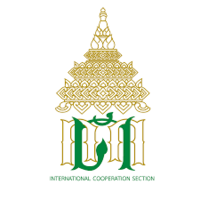
Official name: Thai Customs Department Official website: www.customs.go.th/
Romania Customs
Required documents for customs clearance
Struggling to understand the customs clearance paperwork? Our guide will clarify terms like Bill of Lading, Packing List, Certificate of Origin, and Documents of Conformity (CE standard), helping you smoothly transit goods across borders without confusion or delay. It’s time to step up your global commerce game!
Bill of Lading
Navigating the shipping route from Thailand to Romania? A crucial ally in your journey is the Bill of Lading, your Batman in the world of freight forwarding. It’s an official document that hands over the baton of ownership from the shipper to the receiver. Let’s demystify it further: The ‘telex’ or electronic release is your digital sidekick, accelerating processing times and reducing paperwork – a real boon for busy businessmen like you.
Flying your goods instead? Swap the Bill of Lading for an AWB (Air Waybill). Same superpowers; different transportation mode. Remember, whether it’s a spicy Tom Yum or stack of furniture, these documents confirm what’s shipped, guaranteeing transparency and security in your logistics chain. Use them wisely to clear the hurdles of customs between Bangkok and Bucharest. The power is in your hands.
Packing List
Looking to ship goods from Thailand to Romania? You’ll be needing a Packing List – it’s like your shipment’s travel diary, itemizing what’s packed and where. Whether it’s handmade Thai silk scarves or intricate Romanian wood carvings, it all needs to be listed, weight included. For ocean or air freights, this document is your lifeline.
Customs officials, both Thai and Romanian, rely on your Packing List to inspect and clear your goods. The magic to success? Being accurate down to the last gram. Imagine a shipment of 5,000 Thai coconuts; misquoting to 6,000 messes up customs calculations – a sure-fire way to delay your shipment.
So, remember, while preparing your Packing List, detail is king. Leave no room for guesswork, and you’re well on your way to getting your shipment smoothly from Bangkok to Bucharest.
Commercial Invoice
Getting your Commercial Invoice right can simplify customs clearance when shipping goods from Thailand to Romania. This critical document lists product value, quantity, country of origin, and crucial details about your goods. Its accuracy counts, as it’s a primary reference for customs duties calculation. Misalignment with other shipping documents could result in delays or penalties. So, double-check if the details tie up with those on your Bill of Lading or Airway Bill. An actionable tip? Include a comprehensive description of your goods in English and use Harmonized System (HS) codes for universally recognized product classification. Remember, your invoice isn’t just a list—it’s a blueprint for seamless transportation and custom clearance. So, keep it clear, precise and in sync with other documents—your shipment’s smooth journey depends on it.
Certificate of Origin
Navigating the customs maze between Thailand and Romania? Then you’ll certainly need your Certificate of Origin (CoO). This critical document shows the original country where your goods are crafted, clarifying any doubts about their birthplace. Why does it matter? It could land you some great perks – like access to preferential duty rates under international trade agreements. Imagine you’re shipping auto parts from Bangkok to Bucharest. If your goods were made in Thailand and you have their CoO, they might enjoy lower or even waived customs duties, thanks to Free Trade Agreements. So never underestimate this official piece of paper; it could be your ticket to a smoother, more cost-effective shipment.
Certificate of Conformity (CE standard)
Meeting the CE standard with your merchandise is crucial if you want to send goods from Thailand to Romania. This certification tells the European market, Romania included, that your product complies with their rigorous health, safety, and environmental standards. Unlike general quality assurance, which broadly indicates a product’s quality, the CE certificate specifically ensures the product’s conformity with European standards. It’s akin to the UL certification in the US. However, acquiring this certification necessitates a thorough review of the product against European regulations, often requiring third-party involvement. So, before shipping your Thai-made goods to Romania, ensuring they carry the CE mark can potentially sidestep customs-related complications down the line.
Your EORI number (Economic Operator Registration Identification)
Shipping goods between Thailand and Romania calls for an EORI number. It’s a unique identifier, a must-have for businesses and individuals exporting or importing goods within the European Union. Without it, your transport might hit a serious speed bump. It’s all about tracking: each shipment across borders gets monitored with your EORI number. Remember, Romania is in the EU, so don’t overlook this crucial piece of the puzzle. Registration is relatively streamlined; you can apply online through your country’s customs authority website. Imagine the EORI as your intercontinental passport, smoothing the path for your goods’ journey from Asia to Europe.
Get Started with Siam Shipping
Prohibited and Restricted items when importing into Romania
Understanding what you can’t ship to Romania is crucial to avoid penalties or shipment hold-ups. This section highlights items that are either barred or require special permissions. Let’s clear the confusion and keep your goods moving smoothly.
Are there any trade agreements between Thailand and Romania
Thailand and Romania have several key trade agreements, including the Double Taxation Avoidance Agreement (DTA) signed in 1996, the Agreement on Trade and Economic Cooperation (ATEC) signed in 1998, the Convention on Promotion and Protection of Investments (PPIGA) signed in 2003, a Memorandum of Understanding (MoU) on Cooperation in the Field of Tourism signed in 2004, and a Protocol establishing the Joint Committee of Trade Cooperation signed in 1999.
In addition to formal agreements, both countries hold regular high-level dialogues and ministerial-level meetings, resulting in various MoUs and joint venture agreements. Thailand has become Romania’s largest trading partner in Southeast Asia, with bilateral trade reaching US$1.8 billion in 2022. The relationship is mutually beneficial, providing Thailand access to Romania’s growing market and Romania benefiting from Thai investment, technology transfer, and agricultural products. The trade and economic ties between the two countries are expected to continue growing.
Thailand – Romania trade and economic relationship
In the realm of economic relations, Thailand and Romania share a history characterized by steady growth and collaboration. Established decades ago, ties began with the export of primary commodities and gradually evolved. Today, the relationship encompasses diverse sectors, from manufacturing to ICT. Romanian investments in Thailand have surged, pushing past the $10 million mark in recent years. Conversely, Thai investments in Romania, tagged especially in the food processing sector, also showcase a tangible increase.
The trade volume between the two nations recorded a decent figure of $165 million towards the end of the economic year 2022. Key goods exchanged include machinery, electronics, and agriculture products. The reciprocative economic ventures and innovative cooperation schemes are valid testaments of the progressive Thailand-Romania trade and economic envelope.
Your first steps with Siam Shipping
Additional logistics services
Warehousing
Finding a tried-and-true warehousing solution in Thailand or Romania can be like finding a needle in a haystack. Yet, it's crucial, especially when temperature control is a lifeline for your goods. Tired of playing warehouse roulette? Then make a move and explore ambient, chilled, or frozen storage solutions that match your needs perfectly. More info on our dedicated page: Warehousing.
Packing
Choosing the right packaging solutions ensures the safety of your goods during transit from Thailand to Romania. Dealing with a reputable agent, you can opt for custom-fit wooden crates for items like machinery, or logistical returns on textile shipments, for example. More info on our dedicated page: Freight packaging.

Transport Insurance
Transporting goods carries risks, unlike your static warehouse where fire insurance suffices. With cargo insurance, you're secured against those unpredictable elements of transits, such as damage during loading or natural disasters. Think of it as your peace of mind in every shipment, reducing monetary loss when unforeseen incidents occur. Discover how such prevention works at your fingertips on our dedicated page: Cargo Insurance.
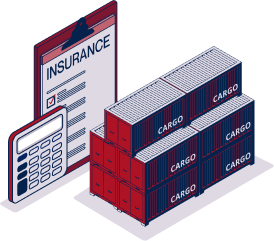
Household goods shipping
Moving between Thailand and Romania? Whether it's grandma's china or that hill tribe-woven rug, we ensure that your fragile or bulky items are handled with utmost care. Our flexible shipping options have got you covered. Like when George, a frequent expat, trusted us to safely ship his glass art collection. More info on our dedicated page: Shipping Personal Belongings.
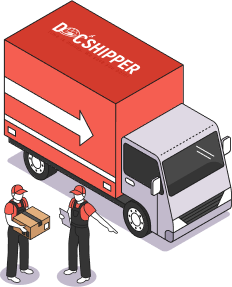
Procurement in Thailand
Looking to connect with suppliers in Asia or East Europe? DocShipper has you covered. We make the daunting task of sourcing and manufacturing hassle-free. From overcoming language barriers to handling the intricate procurement process, we offer a seamless experience. Just think of us as your trusted guide in this journey. Together, we can surmount any challenge. For full details, visit our Sourcing Services page.

Quality Control
Ever shipped goods from Thailand to Romania only to discover product quality issues? Our Quality Control service is a lifeline for you. We organize thorough inspections during manufacturing to ensure your goods meet set standards (think no more subpar textiles or faulty electronics). Real-world example in mind - a car part manufacturer avoiding hundreds of recalls thanks to rigorous QC checks. Intrigued? More info on our dedicated page: Quality Inspection.
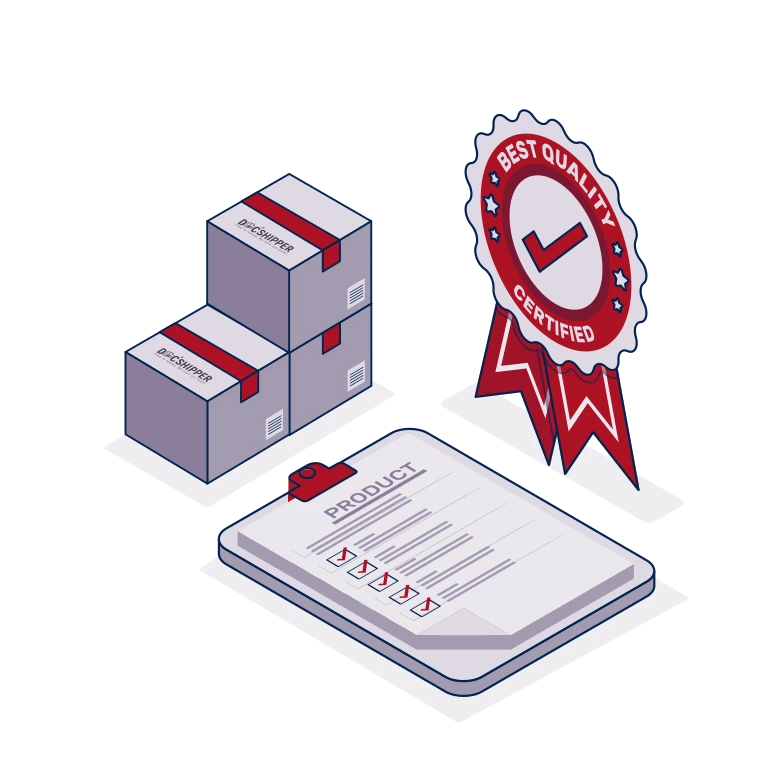
Conformité des produits aux normes
Are you feeling overwhelmed by complex international regulations? Don't let compliance be a hindrance to your trade. We offer Product Compliance Services that ensure your goods meet all necessary requirements. Our labs perform detailed tests for certification, verifying your product's alignment with destination regulations. This means fewer custom issues and smoother business operations for you. Dive deeper into this topic on our dedicated page: Product Compliance Services here.






